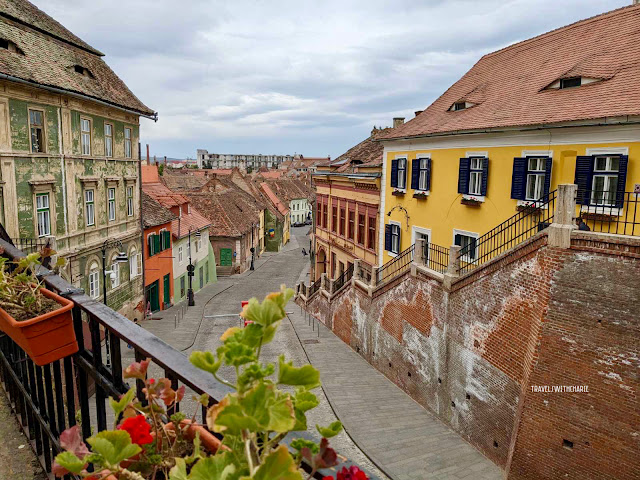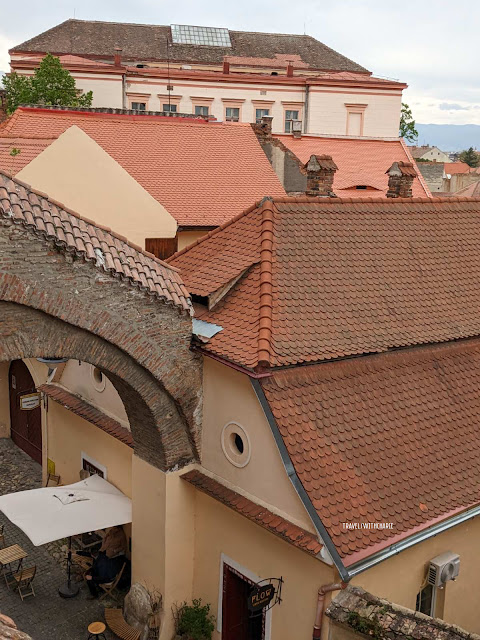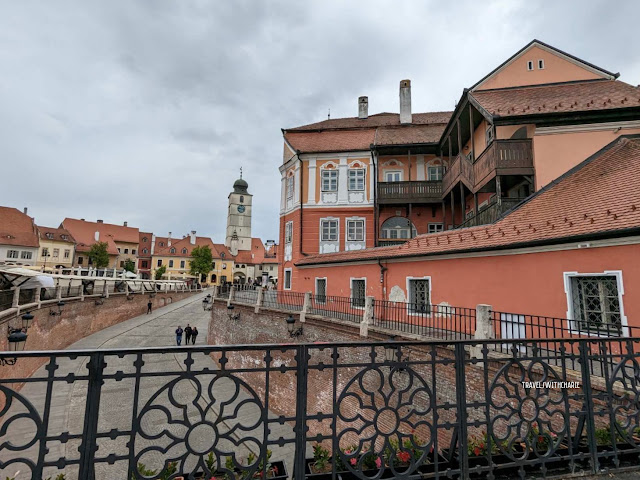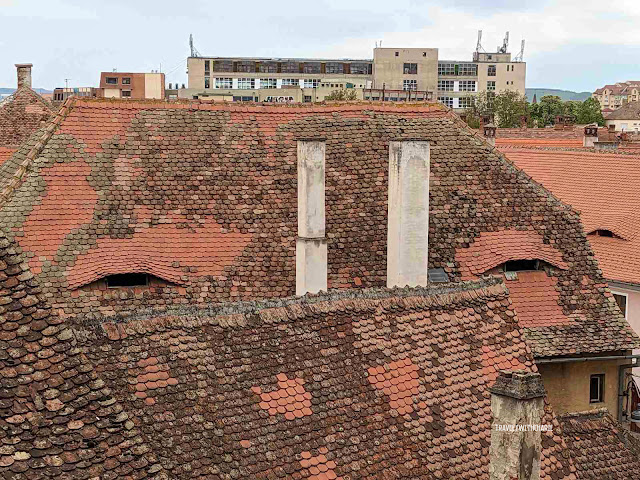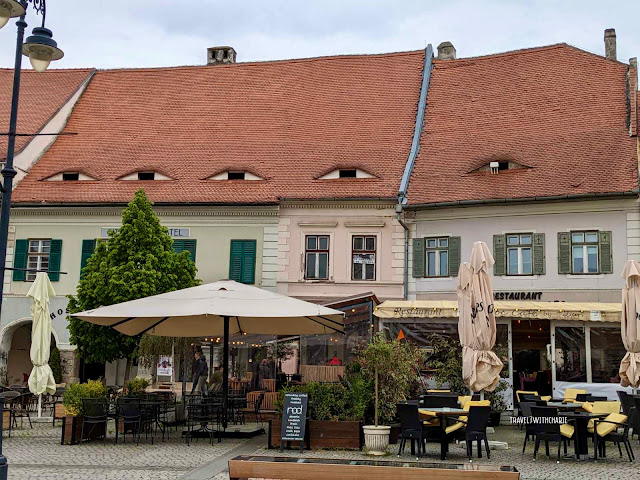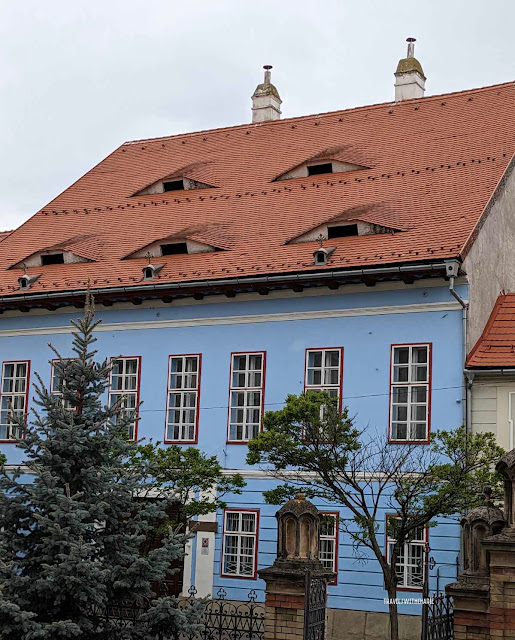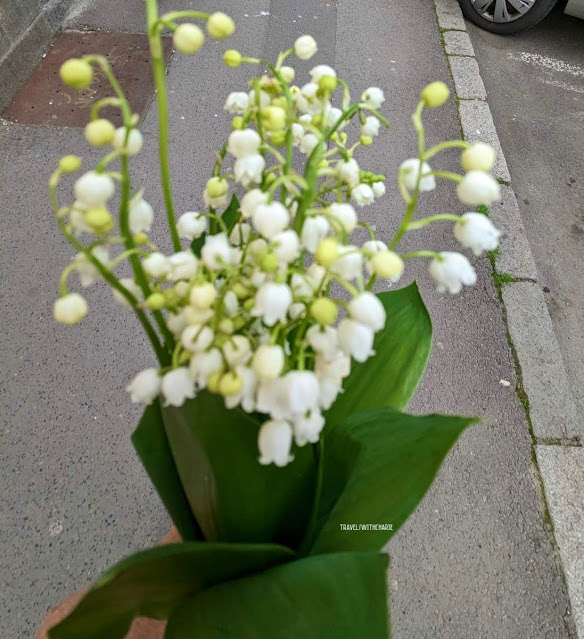The Lower Town from the Bridge of Lies
Romania has been on my travel bucket list for some time and finally in May of this year, my dream happened! I made a list of the places I wanted to see while in Romania and researched ways to get there but didn’t have a viable plan before I left home. When I arrived in Bucharest I finally weighed all the options and it looked bleak. Then I found Nicolas Experience Tours on Trip Advisor. What a relief it was that Nicolas was available to take me to all the cities on my list! Sibiu caught my eye from the get go. Why did this town appeal to me the most? The images below will shed light on why I only have “eyes” for Sibiu.
Piața Mare or Grand Square with
Sibiu City Hall and the Church of the Holy Trinity in the background
What struck me about this square as we entered it from Nicolae Balcescu street was how expansive it is. There’s so much space to roam around and admire the centuries old buildings dipped in pastel hues that surround the Piața Mare.
Beautiful pink columns line the length of the nave of the Baroque style interior of the Holy Trinity. This is a Roman Catholic church consecrated in 1733. It is also known as the Jesuit Church.
House of Caryatids
This 18th century house was previously called “la virginele de piatra” (stone virgins). It’s on Strada Mitropoliei 13.
Detail of the caryatids
Detail of the caryatids
Holy Trinity Orthodox Cathedral
Emperor Franz Joseph I was the first donor to contribute toward the construction of this red and yellow brick striped Cathedral. It has an impressive Byzantine style nave inspired by the Hagia Sofia in Constantinople. It’s on Strada Mitropoliei 33.
Octavian Smigelschi, who hailed from a nearby village in Sibiu county, painted the iconostasis and Christ the Pantocrator on the cupola of the Orthodox Cathedral. Notice the light emanating from the windows surrounding the cupola.
The Neo Byzantine nave and the gilded wooden iconostasis of the Orthodox Cathedral are stunning. The frescoes are vibrant with color and light.
A buttress extends from the upper town to the lower town.
A view of the 13th century Turnul Sfatului (Council Tower) from the Bridge of Lies. The Tower has one of the best views of Sibiu.
Journeymen Pillar
When journeymen finished their training, it was a tradition for them to leave a memento of their trade on the wooden pillar which is in front of the house (Casa Calfelor) where they stayed as an apprentice. Notice the stone dragon seated at the top of the pole. You’ll find it on Piata Huet 3.
St. Mary’s Evangelical Cathedral
St. Mary’s was built in the 14th century in the Gothic style. Its tower is the tallest building in Sibiu at 73.34 meters (240.6 ft.) with 192 steps leading up to the observation platform. Four turrets cover the four corners of the tower and represent “the right of the sword” or the city’s right to sentence criminals to death. What a grim message for a church to relay! More gruesome still was the murder of Prince Minhea Cel Rău (the Evil One), who was the eldest son of Vlad Tepes (the Impaler) in front of this Cathedral in 1510. His tomb is behind the Cathedral’s organ.
Careful what you say when crossing this cast iron pedestrian bridge. It’s said that when you’re caught telling a lie on this bridge, the bridge will collapse. Apparently, there are not just eyes watching you everywhere in Sibiu, there are also big ears listening. Notice the building across the bridge with watchful eyes positioned on both sides of the roof.
One eyed Jack
The eyes have it, as they say. Which is why it’s totally fascinating to see them all around town. Were they really built for spying on the people? Perhaps. But these eyes were mainly used for ventilation and to bring in natural light. On Nicolae Balcescu street.Two Sleepy eyes
View from Piata Albert Huet of the rooftops of the lower town.
Third eye spirituality
View from the Bridge of Lies.
Address: Piața Mică
Five intelligent eyes to rival the Alliance
This is the office of the Orthodox Archbishop of Sibiu and Metropolitan of Transylvania. It’s on Strada Mitropoliei, across from the Holy Trinity Orthodox Cathedral.
Sibiu manhole
This manhole reminds us that Hermannstadt was the former name of Sibiu in the 12th century when it was a (German) Saxon colony.This street is named after Nicolae Balcescu, the Romanian historian, author and revolutionary fighter. Balcescu worked tirelessly to unite all Romanians under one unified state. It is a pedestrian only shopping street connecting the Grand Square with Unirii Square. The violet painted house was the birthplace of popular writer and lawyer, Ioan Borcia. The green house was the home of the Bielz family since the mid-19th century. It was also the office of the Women’s Association of Sibiu (Frauenverein Hermannstadter) led by Josefine Bielz. And one more thing to look for on this street is the crêpe storefront that has delicious fruit-filled crêpes. *Image from Nicolas Experience Tours.
Lily of the Valley
The Lily of the Valley blooms from mid-spring to early summer. If you’re in Sibiu around this period, you’ll find street vendors trying to make a sale with this bouquet. These lilies not only smell good, they also represent purity, joy, love, luck and a return to happiness. So if you receive a lily of the valley bouquet, count yourself lucky and smile.
Hope to see you again, Sibiu.
Where to pick up a snack:
On Nicolae Balcescu Street, there is a tiny storefront selling delicious elongated crêpes with your choice of filling. I got the blueberry one.
Nicolas Experience Tours guided me around Transylvania for a couple of days. I didn’t have to worry about logistics. This is by far the best way to discover the region if you’re planning to visit several cities. Here’s my review about Nicolas Experience Tours published by Trip Advisor:
“In this private tour, I was able to see at a leisurely pace, the places that were on my bucket list like Sighisoara, Sibiu and Brasov. Nicolas is an excellent guide, knowledgeable with history and considerate with my time and schedule preferences. He never failed to ask me what I wanted to see and experience in these historic towns and took me to off the beaten path places. Will certainly ask him again to show me other destinations in the near future.”
Currency: 1 Romanian leu=US$0.22 in June 2023
Power plug and voltage: 230V and the frequency is 50Hz. You’ll need a travel adaptor with rounded pins.
*****
Images by TravelswithCharie unless otherwise indicated.
